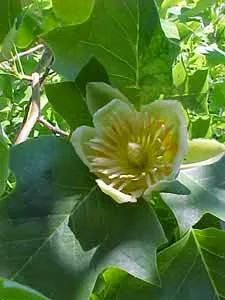By Liliana Usvat
Blog 275-365
Other Names Liriodendron tulipifera
One of the tallest native trees of eastern North America, features uniquely shaped leaves and large yellow tulip-shaped flowers which are hard to see because of the height of the tree; needs lots of moisture and room to grow, not for small properties
Characteristics

Blog 275-365
Other Names Liriodendron tulipifera
One of the tallest native trees of eastern North America, features uniquely shaped leaves and large yellow tulip-shaped flowers which are hard to see because of the height of the tree; needs lots of moisture and room to grow, not for small properties
Characteristics

Tuliptree will grow to be about 90 feet tall at maturity, with a spread of 50 feet. It has a high canopy with a typical clearance of 10 feet from the ground, and should not be planted underneath power lines. It grows at a fast rate, and under ideal conditions can be expected to live to a ripe old age of 120 years or more; think of this as a heritage tree for future generations!
This tree should only be grown in full sunlight. It prefers to grow in average to moist conditions, and shouldn't be allowed to dry out. It is not particular as to soil pH, but grows best in rich soils. It is quite intolerant of urban pollution, therefore inner city or urban streetside plantings are best avoided.
Tuliptree has buttery yellow cup-shaped flowers with yellow eyes and orange centers held atop the branches from mid to late spring. It has emerald green foliage throughout the season. The square leaves turn an outstanding gold in the fall. The fruit is not ornamentally significant. The furrowed gray bark is extremely showy and adds significant winter interest.
The Tulip Tree Liriodendron tulipifera is a member of the Magnolia Family Magnoliaceae and one of our tallest (to 150 feet) and most beautiful native hardwood trees. The tulip trees are in full flower, which you might miss unless you look up into the tree to find them. Their stunning orange- yellow flowers, set off by glossy, star-shaped leaves are too often overlooked, as they are usually way above our heads.
Food for Wildlife
The tree is a significant source of food for wildlife, as food and habitat for bees and a stately shade tree for large areas. It ranges throughout the Eastern United States from southern New England, west to southern Ontario and Michigan, and south to north-central Florida and Louisiana.
Use
Some references say Tulip Tree roots were used as a flavoring to take the bitterness out of Spruce Beer.
Tulip Trees were used to make honey. For just a short time while the tree is blossoming there is a small amount of very sweet nectar in each blossom. It is heavy and honey-flavored. You can drink it directly from the blossom.
The expert was relying on old reports that probably didn’t describe how the natives used the tree. They weren’t collecting honey, they were collecting nectar. The tree was also called the Sap Poplar, perhaps because its sap is consumable.
Medicinal Uses of AFRICAN TULIP TREE, SPATHODEA CAMPANULATA
- A decoction of the bark is astringent and used as a laxative as well as for cases of dysentery and for other gastro-intestinal problems.
- A decoction of the bark and leaves is used as a lotion for inflamed skin and on rashes.
- The flowers can be applied directly onto wounds, as can the bruised leaves which have mild pain-killing and anti-inflammatory properties. Both the bark and leaves have been found to have antiseptic actions.
- An infusion of the leaves is used for urethral infections, and the dried and pulverized or even the fresh inner bark is applied to oozing ulcers. The tree also has UV absorbing properties and could be utilized as a cheap sunscreen.
- Studies have found that the stem bark can lower blood sugar levels and so the traditional use of the bark for diabetes sufferers seems to have been borne out. (Journal of Phytotherapy Research,
- Extracts of the bark, leaves and roots have also been used to combat malaria and HIV and have antimicrobial and antifungal properties.
Indian Tulip Tree Medicinal Uses Thespesia populnea
- The bitter inner bark of the Indian Tulip tree is used as diuretic and stimulant. Its raw green bark is also chewed as an aphrodisaic.
- Its tea is used in the treatment of indigestion,
- dysentery,
- rheumatism,
- coughs and
- fevers.
- In India its bark was used to treat the skin diseases, and
- haemorrhoids.
- Its leaves are applied to the inflamed and swollen joints.
- It is also used in the treatment of ringworm.
- Its roots are used as the tonic.
Indian Tulip tree is found in the lower dry forests to the wet forests. Deep, rich, well-drained soils of forest coves and lower mountain slopes. It is widely grown in the Eravikulam National Park in India..











